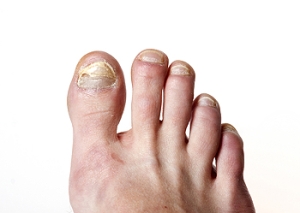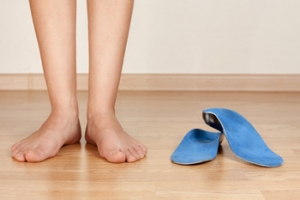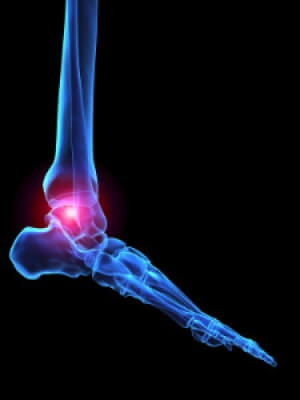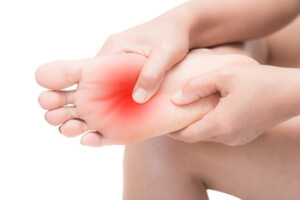Oceanside (760) 630-9200

What Is Used to Treat Toenail Fungus?
Fungal toenail infections can be unsightly, causing the nails to thicken and become brittle, crumbly, and discolored. In severe cases, the nail may separate from the nail bed, which can be painful. People with diabetes should also be wary of toenail fungus, as it can lead to complications if left untreated. A podiatrist may prescribe various medications to treat toenail fungus. Topical medications are applied directly to the nail, often in the form of a cream or medicated nail polish. Oral medications are taken by mouth and help new, uninfected nails to grow in. Sometimes, a podiatrist may prescribe both treatments simultaneously, however, it can take months for an infection to clear up. If you have toenail fungus, please consult with a podiatrist to determine what treatments may be right for you.
For more information about treatment, contact Dr. Jeff Brooks of Oceanside Foot & Ankle Center. Our doctor can provide the care you need to keep you pain-free and on your feet.
Toenail Fungus Treatment
Toenail fungus is a condition that affects many people and can be especially hard to get rid of. Fortunately, there are several methods to go about treating and avoiding it.
Antifungals & Deterrence
Oral antifungal medicine has been shown to be effective in many cases. It is important to consult with a podiatrist to determine the proper regiment for you, or potentially explore other options.
Applying foot powder on the feet and shoes helps keep the feet free of moisture and sweat.
Sandals or open toed shoes – Wearing these will allow air movement and help keep feet dry. They also expose your feet to light, which fungus cannot tolerate. Socks with moisture wicking material also help as well.
If you have any questions please feel free to contact our office located in Oceanside, CA . We offer the newest diagnostic tools and technology to treat your foot and ankle needs.
Toenail Fungus
Toenail fungus is a frustrating problem that affects many people. It can be persistent and hard to get rid of. As many different types of fungi are present throughout the environment, it is very easy to contract toenail fungus.
The feet are especially susceptible to toenail fungus because shoes and socks create the ideal dark and moist environment that fungal infections thrive in. While fungal infections of the nail plate are quite common, if left untreated they can spread beyond the toenail and into the skin and other parts of the body.
Signs of toenail fungus include a thickened nail that has become yellow or brown in color, a foul smell, and debris beneath the nail. The toe may become painful due to the pressure of a thicker nail or the buildup of debris.
Treatment for toenail fungus is most effective during the early stages of an infection. If there is an accumulation of debris beneath the nail plate, an ingrown nail or a more serious infection can occur. While each treatment varies between patients, your podiatrist may prescribe you oral medications, topical liquids and creams, or laser therapy. To determine the best treatment process for you, be sure to visit your podiatrist at the first signs of toenail fungus.
Benefits of Orthotic Inserts
 Orthotics are inserts that are placed inside of your shoes. They are used to correct foot deformities, treat or prevent certain foot problems, and provide comfort and support to the foot. Orthotics can be custom-made or bought over the counter. They can cushion and support your feet as you go about your day. They may be especially helpful for people who have flat feet or high arches, which can be uncomfortable and cause aches and pains in the feet and higher up in the body. Some people’s feet roll too far inwards (overpronation) or outwards (underpronation) when they walk, which can increase the risk of certain injuries. Orthotics can correct foot alignment problems and dysfunctional gaits or walking patterns. Consult with a podiatrist to find out more about orthotics and see if they are right for you.
Orthotics are inserts that are placed inside of your shoes. They are used to correct foot deformities, treat or prevent certain foot problems, and provide comfort and support to the foot. Orthotics can be custom-made or bought over the counter. They can cushion and support your feet as you go about your day. They may be especially helpful for people who have flat feet or high arches, which can be uncomfortable and cause aches and pains in the feet and higher up in the body. Some people’s feet roll too far inwards (overpronation) or outwards (underpronation) when they walk, which can increase the risk of certain injuries. Orthotics can correct foot alignment problems and dysfunctional gaits or walking patterns. Consult with a podiatrist to find out more about orthotics and see if they are right for you.
If you are having discomfort in your feet and would like to try orthotics, contact Dr. Jeff Brooks from Oceanside Foot & Ankle Center. Our doctor can provide the care you need to keep you pain-free and on your feet.
What Are Orthotics?
Orthotics are inserts you can place into your shoes to help with a variety of foot problems such as flat feet or foot pain. Orthotics provide relief and comfort for minor foot and heel pain but can’t correct serious biomechanical problems in your feet.
Over-the-Counter Inserts
Orthotics come in a wide variety of over-the-counter inserts that are used to treat foot pain, heel pain, and minor problems. For example, arch supports can be inserted into your shoes to help correct overarched or flat feet, while gel insoles are often used because they provide comfort and relief from foot and heel pain by alleviating pressure.
Prescription Orthotics
If over-the-counter inserts don’t work for you or if you have a more severe foot concern, it is possible to have your podiatrist prescribe custom orthotics. These high-quality inserts are designed to treat problems such as abnormal motion, plantar fasciitis, and severe forms of heel pain. They can even be used to help patients suffering from diabetes by treating foot ulcers and painful calluses and are usually molded to your feet individually, which allows them to provide full support and comfort.
If you are experiencing minor to severe foot or heel pain, it’s recommended to speak with your podiatrist about the possibilities of using orthotics. A podiatrist can determine which type of orthotic is right for you and allow you to take the first steps towards being pain-free.
If you have any questions please contact our office located in Oceanside, CA . We offer the newest diagnostic and treatment technologies for all your foot and ankle needs.
Ankle Foot Orthotics for Athletes
Ankle foot orthotics are shoe inserts that offer support to control the placement and movement of the ankle, correct deformities, and compensate for weakness. These inserts are used to stabilize the foot and ankle and provide toe clearance during the swing phase of gate.
Athletes often suffer foot problems because their feet are not being supported within the shoe. Ankle and foot orthotics are custom made inserts that alleviate stress on the foot. However custom orthotics should be prescribed by a podiatrist who specializes in customized footwear and orthotics design. These inserts are used by athletes for different reasons. Runners use orthotics to absorb shock at heel contact and to set up the forefoot for push-off. Basketball players wear them to control their forefeet while jumping and running.
The two main types of orthotics are over-the-counter orthotics and custom-made orthotics. To be eligible for custom orthotics, an examination of the foot and ankle will need to be completed. Afterward, both the foot and ankle will need to be casted and fitted for the proper orthotic. When the fitting process is complete, adjustments can be made to make sure everything fits perfectly.
Over the counter orthotics tend to be more popular than custom fit ones. Athletes who have less severe aches and pains in the foot, ankle or lower back area can use the over-the-counter version of orthotics. Unfortunately, over-the-counter orthotics tend to not work in treating severe injuries or ailments. Whenever you suspect you may need an ankle foot orthotic, you should consult with your podiatrist to determine which type of orthotic is right for you.
Arthritis Can Cause Pain in the Feet and Ankles
What Causes Ankle Arthritis?
 Ankle arthritis is caused by damage to the cartilage, which covers the ends of the bones that make up the ankle joint. Cartilage provides a smooth, cushioned surface for the bones to move along, and when it deteriorates, symptoms like joint pain and stiffness follow. There are several processes that can damage or deteriorate the cartilage in the ankle joint. Major ankle injuries, such as ankle fractures, can greatly increase the risk of developing ankle arthritis. More minor, but repetitive trauma to the joint from sprains or chronic instability can have a similar effect. Improper foot biomechanics from flat feet, high arches, and other deformities, can make the cartilage wear away over time. Rheumatoid arthritis, which is an autoimmune condition, can damage the cartilage through inflammation of the lining of the joint. Gout, pseudogout, and infectious arthritis can also damage the cartilage. If you are suffering from joint stiffness, pain, or reduced mobility in your ankles, please seek the care of a podiatrist.
Ankle arthritis is caused by damage to the cartilage, which covers the ends of the bones that make up the ankle joint. Cartilage provides a smooth, cushioned surface for the bones to move along, and when it deteriorates, symptoms like joint pain and stiffness follow. There are several processes that can damage or deteriorate the cartilage in the ankle joint. Major ankle injuries, such as ankle fractures, can greatly increase the risk of developing ankle arthritis. More minor, but repetitive trauma to the joint from sprains or chronic instability can have a similar effect. Improper foot biomechanics from flat feet, high arches, and other deformities, can make the cartilage wear away over time. Rheumatoid arthritis, which is an autoimmune condition, can damage the cartilage through inflammation of the lining of the joint. Gout, pseudogout, and infectious arthritis can also damage the cartilage. If you are suffering from joint stiffness, pain, or reduced mobility in your ankles, please seek the care of a podiatrist.
Arthritis can be a difficult condition to live with. If you are seeking treatment, contact Dr. Jeff Brooks from Oceanside Foot & Ankle Center. Our doctor can provide the care you need to keep you pain-free and on your feet.
Arthritic Foot Care
Arthritis is a joint disorder that involves the inflammation of different joints in your body, such as those in your feet. Arthritis is often caused by a degenerative joint disease and causes mild to severe pain in all affected areas. In addition to this, swelling and stiffness in the affected joints can also be a common symptom of arthritis.
In many cases, wearing ill-fitting shoes can worsen the effects and pain of arthritis. Wearing shoes that have a lower heel and extra room can help your feet feel more comfortable. In cases of rheumatoid arthritis, the arch in your foot may become problematic. Buying shoes with proper arch support that contour to your feet can help immensely.
Alleviating Arthritic Pain
- Exercises that stretch the foot can prevent further pain and injury and increase mobility
- Most of the pain can be alleviated with anti-inflammatory drugs, heat, and topical medications
- Massages can help temporarily alleviate pain.
It is best to see your doctor for the treatment that is right for your needs and symptoms. Conditions vary, and a podiatrist can help you determine the right method of care for your feet.
If you have any questions, please feel free to contact our office located in Oceanside, CA . We offer the newest diagnostic tools and technology to treat your foot and ankle needs.
Arthritic Foot Care
During your lifetime, you will probably walk about 75,000 miles, which is quite a lot of stress to put on your feet. As you get older, the 26 bones and 30 joints in each of your feet will lose flexibility and elasticity. Your foot’s natural shock absorbers will wear down as well. Having arthritis added to this mix only makes matters worse. Your joints will become distorted and inflamed, which is why arthritic foot care needs to be something to think about every day.
When dealing with arthritis, having additional foot complications, such as bunions, hammertoes, or neuroma, can be a serious detriment. To avoid these, buy well-fitting shoes with a lower heel and good support. Arthritis causes you to lose your arch, so having shoes with good arch support is also highly recommended.
Aside from getting good arch support, the shoes need to fit comfortably and properly as well. A good place to start is by leaving a finger width between the back of the shoe and your foot to gauge proper size. It is also helpful to have a square or rounded toe box in the front to provide even more comfort. Another thing to look for is a rubber sole that can provide a cushion and absorb shock as you walk. This adds flexibility to the ball of your foot when you push off your heel to walk.
Exercise is another key aspect of arthritic foot care. Exercise not only strengthens and stretches your muscles and joints, but helps to prevent further injury and pain as well. Stretching the Achilles tendon, the tendon located in the back of your heel, will give you added mobility and reduce pain due to stress. Another thing you can do is massage your feet, kneading the ball of your foot as well as your toes from top to bottom.
Stretching the Achilles tendon is a simple exercise that you can do at home anytime. Lean against the wall with your palms flat against the surface while placing one foot forward, towards the wall, and one foot behind you. Bend your forward knee towards the wall while keeping your back knee locked straight, and make sure both your heels are completely touching the ground at all times. This will stretch your Achilles tendon and calf muscles as well. You will feel the stretch almost immediately. You can also stretch your toes in a couple ways. One involves taking a rubber band and wrapping it around both your big toes while your heels remain together. Then, pull them apart to stretch your big toe. You can also place a rubber band around all the toes of one of your feet. Then, try to separate each individual toe, stretching them all.
A final step you can take to help your arthritis is taking non-steroid, non-inflammatory drugs or topical medicines with capsaicin. Unfortunately, there is no complete way to remove all of your arthritic pain. However, following some of this advice can go a long way in staying as pain-free as possible.
Morton's Neuroma Treatments
 Morton’s neuroma is a condition in which a nerve in the ball of your foot is compressed as surrounding tissues thicken due to injury. Typically the nerve between the third and fourth toes is affected. This can lead to symptoms such as burning pain, tingling, and numbness in the ball of the foot, as well as the strange sensation that you are walking with a pebble in your shoe. Treatments for Morton’s neuroma vary based on the severity of the symptoms. Conservative treatments like footwear modifications and over the counter pain medications are often effective. In cases where conservative treatments fail, steroid injections directly into the foot or decompression surgery may help. For more information about Morton’s neuroma please consult with a podiatrist.
Morton’s neuroma is a condition in which a nerve in the ball of your foot is compressed as surrounding tissues thicken due to injury. Typically the nerve between the third and fourth toes is affected. This can lead to symptoms such as burning pain, tingling, and numbness in the ball of the foot, as well as the strange sensation that you are walking with a pebble in your shoe. Treatments for Morton’s neuroma vary based on the severity of the symptoms. Conservative treatments like footwear modifications and over the counter pain medications are often effective. In cases where conservative treatments fail, steroid injections directly into the foot or decompression surgery may help. For more information about Morton’s neuroma please consult with a podiatrist.
Morton’s neuroma is a very uncomfortable condition to live with. If you think you have Morton’s neuroma, contact Dr. Jeff Brooks of Oceanside Foot & Ankle Center. Our doctor will attend to all of your foot care needs and answer any of your related questions.
Morton’s Neuroma
Morton's neuroma is a painful foot condition that commonly affects the areas between the second and third or third and fourth toe, although other areas of the foot are also susceptible. Morton’s neuroma is caused by an inflamed nerve in the foot that is being squeezed and aggravated by surrounding bones.
What Increases the Chances of Having Morton’s Neuroma?
- Ill-fitting high heels or shoes that add pressure to the toe or foot
- Jogging, running or any sport that involves constant impact to the foot
- Flat feet, bunions, and any other foot deformities
Morton’s neuroma is a very treatable condition. Orthotics and shoe inserts can often be used to alleviate the pain on the forefront of the feet. In more severe cases, corticosteroids can also be prescribed. In order to figure out the best treatment for your neuroma, it’s recommended to seek the care of a podiatrist who can diagnose your condition and provide different treatment options.
If you have any questions, please feel free to contact our office located in Oceanside, CA . We offer the newest diagnostic and treatment technologies for all your foot care needs.















